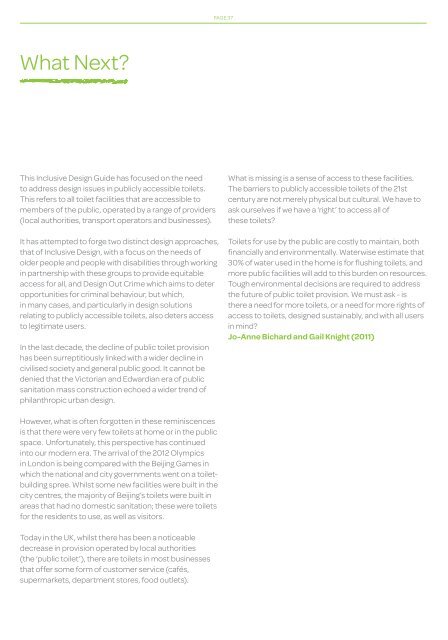Publicly Accessible Toilets An Inclusive Design Guide. - phlush
Publicly Accessible Toilets An Inclusive Design Guide. - phlush
Publicly Accessible Toilets An Inclusive Design Guide. - phlush
- No tags were found...
You also want an ePaper? Increase the reach of your titles
YUMPU automatically turns print PDFs into web optimized ePapers that Google loves.
PAGE 37What Next?This <strong>Inclusive</strong> <strong>Design</strong> <strong>Guide</strong> has focused on the needto address design issues in publicly accessible toilets.This refers to all toilet facilities that are accessible tomembers of the public, operated by a range of providers(local authorities, transport operators and businesses).It has attempted to forge two distinct design approaches,that of <strong>Inclusive</strong> <strong>Design</strong>, with a focus on the needs ofolder people and people with disabilities through workingin partnership with these groups to provide equitableaccess for all, and <strong>Design</strong> Out Crime which aims to deteropportunities for criminal behaviour, but which,in many cases, and particularly in design solutionsrelating to publicly accessible toilets, also deters accessto legitimate users.In the last decade, the decline of public toilet provisionhas been surreptitiously linked with a wider decline incivilised society and general public good. It cannot bedenied that the Victorian and Edwardian era of publicsanitation mass construction echoed a wider trend ofphilanthropic urban design.What is missing is a sense of access to these facilities.The barriers to publicly accessible toilets of the 21stcentury are not merely physical but cultural. We have toask ourselves if we have a ‘right’ to access all ofthese toilets?<strong>Toilets</strong> for use by the public are costly to maintain, bothmore public facilities will add to this burden on resources.Tough environmental decisions are required to addressthe future of public toilet provision. We must ask 2 isthere a need for more toilets, or a need for more rights ofaccess to toilets, designed sustainably, and with all usersin mind?Jo9<strong>An</strong>ne Bichard and Gail Knight (2011)However, what is often forgotten in these reminiscencesis that there were very few toilets at home or in the publicspace. Unfortunately, this perspective has continuedinto our modern era. The arrival of the 2012 Olympicsin London is being compared with the Beijing Games inwhich the national and city governments went on a toilet2building spree. Whilst some new facilities were built in thecity centres, the majority of Beijing’s toilets were built inareas that had no domestic sanitation; these were toiletsfor the residents to use, as well as visitors.Today in the UK, whilst there has been a noticeabledecrease in provision operated by local authorities(the ‘public toilet’), there are toilets in most businessesthat offer some form of customer service (cafés,supermarkets, department stores, food outlets).





